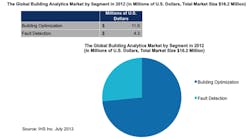The answer to this question seems obvious: of course data is important and has been for years. This magazine has covered the data center market areas for years, and though it is a niche market, it is one that is growing in both size and importance each year.
But what does data mean to design and facilities engineers beyond the data center arena? How does it impact the decisions being made everyday in the operation of commercial buildings and businesses?
The answers to those questions are where the new frontiers lay.
This month, HPAC Engineering features an article written by Robert Cavey, of Praxis (a Washington, D.C. organization focused on global sustainability) and Lisa Tryson of Danfoss North America. In The Data Revolution: How Information Technology Is Transforming Buildings and HVACR, they discuss the use of Building Information Modeling (BIM), monitoring, data processing, and information-transfer technology, to manage building and system performance using data and information gathered from many sources. The data is housed in databases, then accessed, analyzed, and put to use by skilled sales and design teams.
“The result,” say Cavey and Tryson, “ is an industry move toward data-based predictability of building envelope, building systems, temperature profile, power use, carbon footprint, and more.”
But wait, there is more. This data management and design is something that is changing society as much as it is changing business. Michael Hickins, Editor of The Wall Street Journal’s CIO Journal, was quoted in a March 2014 branding analysis and measurement blog post (bit.ly/Data-Driven) about the culture shock of moving away from doing business based on feelings, experience, conversations with customers, to one based on pure data.
Hickins said, “Data is the reality, and most companies are ignoring it. Until they transform that culture, they’re not going to accelerate their business growth.”
Hickins was talking about retail companies, but the truth is, this type of culture shock is found in the mechanical systems engineering world as well — both from the engineering and building owner/customer viewpoints.
HVAC equipment and control systems have been gathering data for years. BIM systems use this and other data to simulate how mechancial systems will work in a given space under almost an infinite array of conditions. Being able to create simulated buildings—in commercial new construction projects, which account for nearly seven percent of the U.S. Gross Domestic Product—to renovation/replacement work allows consulting engineers to work out problems before anything is built and allows facilities engineers to predict where problems might develop, and strategize plans to avoid them BEFORE they happen.
How much of this is happening today? According to William Peterson, director, Big Data Marketing & Strategy, CenturyLink Technology Solutions (bit.ly/CLinkTech), “Even data-driven companies typically analyze only 15 percent of their data, thus leaving potentially valuable insights unseen.”
At issue is the need for people who really understand data: who understand where the opportunities are, what the meaningful insights are, and can take those insights and put them to use in the most effective way.
In the HVAC world, that person will drive the new frontier and lead the next generation of how buildings are designed and used.













